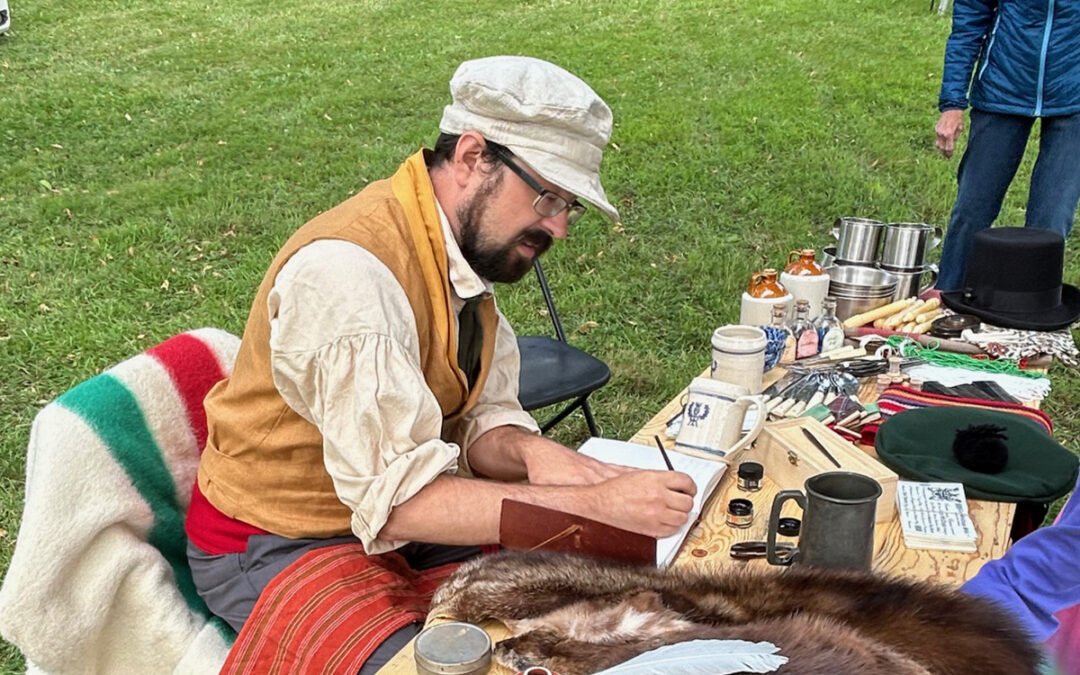I met Brian Hardy at the Huot Chautauqua where he was portraying a fur trader. Interestingly, he gets paid to dress up in historical costumes — he’s the outreach coordinator for the Pembina State Museum, a part of the State Historical Society of North Dakota, in the city of Pembina, North Dakota.
Welcome guest writer, Brian Hardy!
Who’s your fur trade character?

Brian Hardy (photo courtesy of Brian Hardy)
I’m a Scottish highlander who joined the North West Company in Montreal. I signed on as a canoeman for the thrill of adventure — a voyageur doing all the heavy lifting of the fur trade. Thanks to my limited education gained from my father who was a small-time merchant, I am able to read and write. One winter I assisted with clerk duties and, at the next rendezvous, was able to become a clerk. Now I oversee a wintering operation as a part of the Pembina Department for the NWC.
(I tend to keep my fur trader persona generic, either a voyageur or a clerk, depending on the program I’m running.)
What’s the most unusual trade good that you carry?
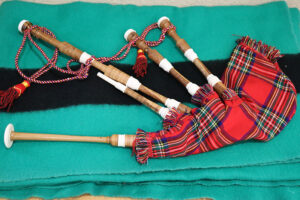
Parlor pipes carried by a settler in Lord Selkirk’s colony. (photo courtesy of Brian Hardy)
When I go en dérourine with the rendezvous program, I bring our parlor pipes, a smaller version of bagpipes. Sadly, I can’t play them — I barely make them squawk when I try. They highlight the role the Selkirk colonists played in the development of the Red River Valley in the early 19th century.
An apocryphal story about those pipes: the colonists were unloaded from their ships a hundred miles north of York Factory and were forced to march to their new home. One person brought bagpipes, which he played the whole time of their march to keep their spirits up. I also try to include items to represent all the various cultures that participated in the fur trade here at Pembina.
What do people ask you about?
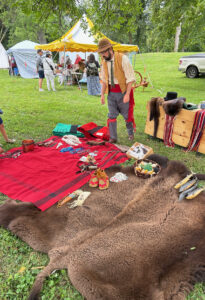
Note the size of the bison robe in Brian Hardy’s fur trade goods!
“What animal is that?” Most questions center around the furs that I bring along. Which are:
the ever-important beaver, whose fur fueled the hat fashion of 18th and 19th century Europe;
a fisher and marten (both represented in our museum’s gallery);
a muskrat;
and a bison robe (which many people mistake for bear fur at first glance).
What do you wish they’d ask?
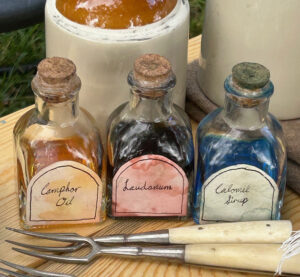 About our patent medicines. I include a few bottles of “medicine” (just colored water) in the display, because medicine is found in many fort returns from the fur trade. The bottles provide a great opportunity to discuss medicine and healthcare in the 18th and early 19th centuries, which is very different from our medicine today.
About our patent medicines. I include a few bottles of “medicine” (just colored water) in the display, because medicine is found in many fort returns from the fur trade. The bottles provide a great opportunity to discuss medicine and healthcare in the 18th and early 19th centuries, which is very different from our medicine today.
When people ask, I get to talk about the “four humors” theory of medicine and how these different tinctures were used and how some — like camphor oil — are still available today. It’s a fascinating topic that I hope to build a whole program around in the future.
Did you ever get stumped by a question (which you probably researched when you got back)?
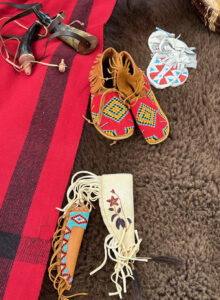 For most of the materials I include, I’ve done lots of research and have a ready answer. That said, sometimes there’s more research to do, or I include an item last minute that I haven’t completely researched.
For most of the materials I include, I’ve done lots of research and have a ready answer. That said, sometimes there’s more research to do, or I include an item last minute that I haven’t completely researched.
I recently was asked about our muskrat fur, which I had been erroneously calling a woodchuck. I am not a naturalist or a botanist, so questions outside of the history and material culture tend to stump me.
What’s most fun about portraying a fur trader? What is the hardest?
 The best part is getting access to all of the fascinating material culture of the 18th and 19th centuries. I travel with several hundred pounds of goods and every piece has a story to tell.
The best part is getting access to all of the fascinating material culture of the 18th and 19th centuries. I travel with several hundred pounds of goods and every piece has a story to tell.
The down side is having to transport all that material mostly by myself, so I designed shelves for the items sit on that also work as storage and transportation containers. They have handles and folding wheels so that I can move all these items around with relative ease.
Another best part is the travel, seeing the different environments from the woods to the plains and beyond. The woods and prairies are beautiful any time of year and I’m lucky to travel through them.
But … then there’s the weather. The elements, especially on the open plains, are not for the faint of heart. Winters are brutally cold and even those who are well-prepared can suffer. I’m like explorers and fur traders from David Thomspon to Alexander Henry who found themselves trapped out by blizzards with nothing but their clothes and a blanket — not everyone makes it through such experiences.
What have you learned about the fur trade as you’ve gotten into this?
Just about everything I know since I started at the museum in 2021. My formal education focused on English and British Imperial history, so I had background in the fur trade of the area, but nothing compared to the detailed knowledge I’ve gained.
What interests me the most is the global reach of the fur trade and learning about the details of the manufacture and transport of the different goods that eventually ended up here.
What’s your day job?
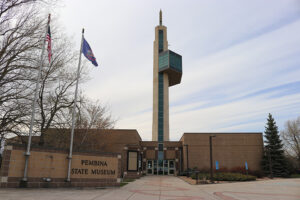
The Pembina State Museum in Pembina, North Dakota (photo courtesy of Brian Hardy)
As outreach coordinator for the Pembina State Museum (part of the State Historical Society of North Dakota, in Pembina, ND), my primary role is to develop, organize and run public programming and oversee tours at the museum and our two satellite sites — the Gingras Trading Post State Historic Site and the Walhalla State Historic Site. My primary responsibility is working on programming, but I also write articles and gallery text from time to time, do the usual administrative work and occasionally assist with site maintenance. And I get paid to play games (educational games, anyway).
How did you get into living history (also called re-enacting)? How long have you been doing this?
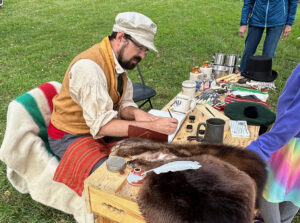
Brian Hardy becomes a Scottish fur trader at the Huot Chautauqua.
When I first started working at the Pembina State Museum, though I’ve carried an interest in it since I was a kid. I wanted to bring as much authenticity as I could to my programming and began developing a fur trade persona to go along with our Red River Rendezvous (a fur trading simulation and game) and similar programming.
Our programming is primarily geared towards schools and designed to complement our North Dakota curriculum.
I visit several schools every year to run our fur trade simulation and give talks. Outside of schools, I visit the Huot Chautauqua as well as local machinery shows and other public events, as part of my job.
Several Bismarck colleagues were also part of the 5th Minnesota Company D Living History Group and invited me to one of their events. I joined them in 2021. Now I regularly portray an infantryman with the 5th Minnesota at Fort Abercrombie, another North Dakota State Historic Site, and at other parks and events throughout North Dakota and in western Minnesota.
- Contact Brian directly at bmhardy@ne.gov.
Final Thoughts
- Read my novel series about a too-young boy experiencing the fur trade. Book 1: “Waters Like the Sky” Book 2: “Treacherous Waters” Book 3: “Uncharted Waters” — all in paper and ebook.
- Subscribe to this blog and read posts as they are published!
- For what I’m researching or quirky discoveries, visit me on Facebook or Instagram (@nlnlnraj): I love your comments.
- Book me as a speaker.
- Ask your library, local school, gift shop to buy copies.
- Become a voyageur for an hour — come to one of my presentations. Next up is “Sacagawea: From Her People’s Eyes” at 3 p.m. Thursday, Dec. 4, at Whitney Senior Center in St. Cloud.
- Consider writing your own chapter — fan fiction — about what else could happen.

